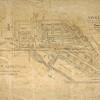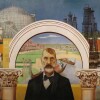How Muscle Beach Started in Santa Monica — But Ended Up in Venice

It was the late 1930s. Abbye “Pudgy” Stockton (then Eville), a blonde, petite California teen, was working as a telephone operator after graduating from Santa Monica High School. Her new sedentary work life caused her to gain weight, which made her feel unhealthy and uncomfortable. At the encouragement of her future husband Les, a UCLA acrobat, she began to work out with light dumbbells, and she loved it.
The couple began training together on a strip of sand right by the Santa Monica Pier now known as Muscle Beach. Pudgy soon proved herself to be an elite athlete, a weightlifting champion, and a gifted acrobat. She and Les would perform at Muscle Beach for thousands of spectators. Their most famous feat was the “high press,” during which Les would lift Pudgy into the air, while she would lift a 100-pound barbell.
Pudgy, whose childhood chubbiness was the reason for her nickname, became a “physical culture” superstar, known as the “First lady of Iron” and “America’s Barbelle.” She wrote a monthly column on women’s health, and she and Les opened gyms where they touted the benefits of exercise and healthy living for men and women. "In those days, lifting weights was considered unfeminine," Pudgy later told Sports Illustrated Women. "People used to say that if women worked out, they would become masculine-looking or wouldn't be able to get pregnant. We just laughed because we knew they were wrong."
More on Muscle Beach and Lost LA
Life-changing transformations like Pudgy Stockton’s were frequent occurrences on Muscle Beach, which during its heyday from the mid-1930s to the mid-1950s brought the excitement and beauty of exercise to the masses. “Every day,” acrobat Glenn Sundby recalled of his time at Muscle Beach, “was a day to look forward to.”
It all started with a children’s playground. Kate Giroux, a local playground instructor, encouraged the city of Santa Monica to install some simple child-friendly equipment on the beach by the pier. The little playground was built with government funds and soon began attracting teens from nearby Santa Monica High School, leading to its first name: High School Beach.


Around 1932, the Los Angeles Olympics that brought a new obsession with sport and competition to Southern California. Acrobats, some who were in-between vaudeville shows, began to work out and practice together at the playground.
“Some young people started working out at the beach informally, using rugs and tarps laid directly on the sand,” writes Marla Matzer Rose in her definitive history “Muscle Beach: Where the Best Bodies in the World Started a Fitness Revolution.” “Within a couple years, a low wooden platform was built. That was replaced by a sturdier, raised platform, and still later, the fully formed, L-shaped platform with its own equipment shed and rows of benches to accommodate the spectators.”

Al Neiderman, a local mechanic and gymnast, built more adult equipment like parallel bars and high rings. This attracted many fitness buffs, including acrobat Johnny Collins; UCLA gymnasts and their coach CeCe Hollingsworth; Pudgy and Les Stockton; Joe Gold, future Gold’s Gym impresario; George Eiferman, the trumpet-playing strongman; Vic Tanny; the legendary Jack LaLanne; stuntman Russ Saunders and his partner Paula Boelsems.
Word began to spread of the magical feats going on at Muscle Beach, and it soon became a major tourist destination. Spectators from all over the world would gather to watch the elaborate shows put on by the athletes. In her book, Rose described a typical July 4th celebration in the mid-1940s:
By early afternoon, several dozen gymnasts, bodybuilders, and weightlifters would have been entertaining the crowd. Professional stuntmen and circus performers were among those onstage. Acrobats would form human pillars, three or four people high, to amuse the crowd. They would do flips and handstands; a brave and brazen few would even go on the rooftops of buildings overlooking the beach and perform their handstands there on the edge of roofs while the crowd gasped and hollered. Several strong women might have come out to lift weights, tear phone books in half, and even “wrestle” with men using martial arts techniques. Girls as young as ten would be part of accomplished teams performing “adagio,” a kind of acrobatic dance.
The beach was not just a gathering place for scantily-clad men and women to show off their sculpted bodies. It was also the hangout of a group of “original hippies” known as the Nature Boys. With names like Gypsy Boots, Gypsy Gene, and Bob Wallace aka Jesus, they promoted healthy, natural eating. “The Nature Boys came to the beach to preach their philosophy to the crowds, sell fruit and nuts to the acrobats and bodybuilders, and add some general levity to the proceedings,” Rose writes. “They made music, cracked jokes, and generally played the part of court jester on Muscle Beach.”


But those who worked out and trained at Muscle Beach did so much more than perform. They taught each other, forming tight-knit fitness circles which would revolutionize the physical fitness industry in America. "It was the only place of its kind in the world," acrobat Glenn Sundby recalled. "Anywhere else, performers, circus or stuntmen, would stay to themselves. Here, they'd teach you the tricks of their profession. It was where I learned my balancing."
Muscle Beach reached its zenith of popularity in the 1950s. “By the ’50s, fans and followers worldwide would write to the stars of Muscle Beach, addressing their letters simply to “Muscle Beach, USA,” Rose writes. But this popularity and the changing face of Muscle Beach would eventually lead to its downfall.
By the early 1950s, many of the original Muscle Beach regulars had gone on to diverse careers in the expanding fitness industry and had grown away from the beach. Instead of acrobats, dancers and gymnasts, less family-friendly “iron men” weightlifters and bodybuilders began to dominate the Beach. According to a 1957 edition of Strength & Health magazine:
Muscle Beach certainly lives up to its name. You want to see muscles — then take a trip to this Biceps Paradise. You want to grow muscles — do likewise. They sprout fast in the California sunshine, and any day a stroll down to the lifting platform will reward your bulging eyes with in-the-flesh glimpses of famous musclemen such as Steve Reeves, George Eiferman, Dick Dubois, Paul Anderson, Ike Berger, and you name 'em, we got 'em.
In 1955, after an accident involving a young boy, the Santa Monica City Council finally saw a way to get rid of Muscle Beach, which the conservative town had long considered a nuisance.


“The ‘Muscle Beach Weightlifting Club’ was formed in 1955 at the insistence of the Santa Monica City Recreation Commission,” Muscle Beach regular Thomas Humphrey recalled. “A panel of officers was elected, a constitution drawn up and by-laws adopted. With part of the funds derived from the annual membership fees an accident insurance policy was set up to protect the members.” The club made improvements to the equipment and attempted to upgrade the facilities, but it was a futile gesture. In the summer of 1957, the City Council announced plans to move Muscle Beach.
Muscle Beach had long been considered by the puritanical an “immoral place” and “a favorite haven of the sexual athletes and queers of Southern California.” This was in part due to their striking physicality, and because many bodybuilders and weightlifters posed in beefcake magazine for a few extra bucks. “Mention Muscle Beach to Southern California’s regional cynics, its wise guys, its soft in body,” the Saturday Evening Post reported, “and you are liable to draw only sniggers and snorts.” Even the bodybuilding magazine Strength & Health reported:
Rumors may have reached you that some queer proceedings transpired on the Beach. We have heard of some pretty odd goings-on ourselves, but we never actually caught anybody in fragrant delicto (or whatever the legal phrase is) on one of our personal visits.
Things finally came to a head in 1958, when five Muscle Beach regulars, including Olympic weightlifters Isaac Berger and David J. Sheppard, were accused of horribly molesting two African-American girls. According to Rose, most of the accused were convicted of some offense, although they were penalized very lightly. In 1959, with the approval of many angry Santa Monica residents, Muscle Beach was forever closed.

The weightlifters and bodybuilders who had called Muscle Beach home in its later years migrated down to the more tolerant and free-wheeling Venice Beach, to an area known as “The Pen.” There, they put on smaller-scale shows that attracted tourists and wanna-be-weightlifters. In 1987, The Pen was formally renamed “Muscle Beach Venice.”
In 1988, a group of Santa Monica Muscle Beach alumni formed the Muscle Beach Alumni Association. They advocated for the workout area and plaque we see today at the original Muscle Beach, a place where a new way of living was exhibited to thousands of people from around the world. As Jack LaLanne recalled decades later, Muscle Beach was “such a perfect place to show kids that anything was possible.”

Top Image: "Miss Muscle Beach" contest, 1951 | Los Angeles Examiner Negatives Collection, 1950-1961/University of Southern California Libraries
















